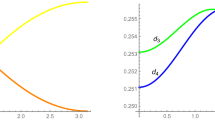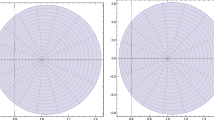Abstract
We present a new subclass \(\mathcal {SL}^{k}\) of starlike functions which is related to a shell-like curve. The coefficients of such functions are connected with \(k\)-Fibonacci numbers \(F_{k,n}\) defined recurrently by \( F_{k,0}=0,F_{k,1}=1\) and \(F_{k,n}=kF_{k,n}+F_{k,n-1}\) for \(n\ge 1\), where \( k \) is a given positive real number. We investigate some basic properties for the class \(\mathcal {SL}^{k}\).
Similar content being viewed by others
Avoid common mistakes on your manuscript.
1 Introduction
Let \(\mathbb {D}=\left\{ z:\left| z\right| <1\right\} \) denote the unit disc. Let \(\mathcal {A}\) be the class of all analytic functions \(f\) in the open unit disc \(\mathbb {D}\) with normalization \(f(0)=0\), \(f^{\prime }(0)=1\) and let \(\mathcal {S}\) denote the subset of \(\mathcal {A}\) which is composed of univalent functions. We say that \(f\) is subordinate to \(F\) in \(\mathbb {D}\), written as \(f\prec F\), if and only if \(f(z)=F(\omega (z))\) for some analytic function \(\omega \), \(\omega (0)=0\), \(\left| \omega (z)\right| <1\), \(z\in \mathbb {D}\). The idea of subordination was used for defining many classes of functions studied in geometric function theory. Let us recall
where \(\varphi \) is analytic in \(\mathbb {D}\) with \(\varphi (0)=1\). For \( \varphi (z)=(1+z)/(1-z)\) we obtain the well-known classes \({\mathcal {S}} ^{*}\), \({\mathcal {K}}\) of starlike and convex functions, respectively. A lot of classes of functions have been defined by exchanging the function \( \varphi \) in (1.1) or in (1.2) by other functions giving very often an interesting image of the unit circle. If \(\varphi (z)=(1+(1-2\alpha )z)/(1-z)\), \(\alpha <1\), then \(\varphi (\mathbb {D})\) is the half plane \( \mathfrak {Re}(w)>\alpha \), and the sets (1.1), (1.2) become the classes \({\mathcal {S}}^{*}(\alpha )\) of starlike or \({\mathcal {K}} (\alpha )\) of convex functions of order \(\alpha \), respectively, introduced in [14]. If \(\varphi (z)=(1+Az)(1+Bz)\), \(-1<B<A\le 1\), then \( \varphi (\mathbb {D})\) is a disc, and the classes (1.1), (1.2) become the classes considered in [6, 7]. The class of strongly starlike functions of order \(\beta \), \(0<\beta \le 1\), see [20] is obtained from (1.1) with \(\varphi (z)=\left( (1+z)/(1-z)\right) ^{\beta }\). Then \(\varphi (\mathbb {D})\) is an angle. If
then \(\varphi (\mathbb {D})\) is a parabolic region, and the set (1.2) is a class of the so-called uniformly convex function introduced in [5, 11, 15]. Close related classes, connected with a hyperbola or with an ellipse were considered in [8–10]. If \( \varphi (z)=\sqrt{1+z}\), where the branch of the square root is chosen in order that \(\sqrt{1}=1\), then \(\varphi (\mathbb {D})\) is interior of the right loop of the Lemniscate of Bernoulli and the class (1.1) becomes a class considered in [17, 19]. The function
in (1.1) forms a class considered in [13]. In the above and in other not cited here cases the function \(\varphi \) is a convex univalent function. In [12] Ma and Minda proved some general results for classes (1.1) and (1.2), where \(\varphi \) is assumed to be univalent, \(\varphi (\mathbb {D})\) is assumed to be symmetric with respect to real axis and starlike with respect to \(\varphi (0)=1\). The problems in the classes defined by (1.1) and by (1.2) become much more difficult if the function \(\varphi \) is not univalent. In [18] the second author defined the class \(\mathcal {SL}\) of shell-like functions as the set of functions \(f\in \mathcal {A}\) satisfying the condition that
where
The class \(\mathcal {SL}\) is a subclass of the class of starlike functions \( \mathcal {S}^{\star }\). The name attributed to the class \(\mathcal {SL}\) is motivated by the shape of the curve
which is a shell-like curve. Furthermore, the coefficients of shell-like functions are connected with well-known Fibonacci numbers \(F_{n}\) defined as
More recently, a lot of new studies have been done about several classes of functions related to shell-like curves connected with Fibonacci numbers (see [1, 2] and [16]).
Motivated by the above studies, we define new subclasses \(\mathcal {SL}^{k}\) of the class \(\mathcal {S}^{\star }\), where \(k\) is any positive real number. The coefficients of such functions are connected with \(k\)-Fibonacci numbers. For \(k=1\), we obtain the class \(\mathcal {SL}\) of shell-like functions.
For any positive real number \(k\), the \(k\)-Fibonacci numbers \(F_{k,n}\) are defined recurrently by
The Fibonacci numbers defined in (1.3) are obtained from (1.4) for \(k=1\). It is known that the n\(^{th}\) \(k\)-Fibonacci number is given by
where \(\tau _{k}=\frac{k-\sqrt{k^{2}+4}}{2}\) (see [3] and [4] for more details about \(k\)-Fibonacci numbers).
2 The Class \(\mathcal {SL}^{k}\)
Definition 2.1
Let \(k\) be any positive real number. The function \(f\in \mathcal {S}\) belongs to the class \(\mathcal {SL}^{k}\) if satisfies the condition that
where
Theorem 2.1
The image of the unit circle of the function \(\widetilde{p} _{k}(z)\) defined in (2.1) is the curve \(\mathcal {C}_{k}\) with equation
Proof
The proof follows by some straightforward calculations.\(\square \)
Recall that the curve which is called conchoid of Sluze has the following equation
where \(a>0\) and \(\lambda >0\). For \(\lambda =2a/k\), the conchoid of Sluze (2.3) becomes the curve
For \(k=1\), this curve is the trisectrix of Maclaurin.
We can find the corresponding Cartesian equation of the curve \(\mathcal {C} _{k}\) with Eq. (2.2) as
If we rewrite (2.5) in the following form
then the image of the unit circle under the function \(\widetilde{p}_{k}\) is translated into a curve with Eq. (2.4), where
Therefore, the curve \(\mathcal {C}_{k}\) has a shell-like shape and symmetric with respect to the real axis, see Fig. 1.
For \(k<2\), note that we have
and so the curve \(\mathcal {C}_{k}\) intersects itself on the real axis at the point \(\frac{k\sqrt{k^{2}+4}}{k^{2}+4}\). Thus, \(\mathcal {C}_{k}\) has a loop intersecting the real axis at the points \(e=\frac{k\sqrt{k^{2}+4}}{k^{2}+4}\) and \(f=\frac{\sqrt{k^{2}+4}}{2k}\). For \(k\ge 2\), the curve \(\mathcal {C}_{k}\) has no loops and it is like a conchoid.
Corollary 2.1
For each \(k>0\), \(\mathcal {SL}^{k}\subset \mathcal {S}^{*}(\alpha _{k})\), where \(\alpha _{k}=\frac{k\sqrt{k^{2}+4}}{2\left( k^{2}+4\right) }=\frac{ k\left( k-2\tau _{k}\right) }{2\left( k^{2}+4\right) }\), that is, \(f\in \mathcal {SL}^{k}\) is starlike of order \(\alpha _{k}\).
The function \(\widetilde{p}_{k}\) defined in (2.1) is not univalent in \(\mathbb {D}\). For example, we have \(\widetilde{p}_{k}(0)=\widetilde{p}( \frac{-k}{2\tau _{k}})=1\) and \(\widetilde{p}(1)=\widetilde{p}(\tau _{k}^{4})= \frac{\sqrt{k^{2}+4}}{2k}\). We can give the following theorem.
Theorem 2.2
For each \(k>0\), the function \(\widetilde{p}_{k}\) is univalent in the disc \( \mathbb {D}_{r_{k}}=\left\{ z:\left| z\right| <r_{k}\right\} \), where
and it is not univalent in the disc \(\mathbb {D}_{r_{k}}\) for each \(r\ge r_{k}\).
Proof
Suppose that \(\widetilde{p}_{k}(z)=\widetilde{p}_{k}(w)\) for some \(z,w\in \mathbb {D}\) . After some calculations we have
We see that the function
maps a circle \(\left| z\right| =r<2/(k\tau _{k})\) onto a circle centred at \(m=-\frac{2k(1+\tau _{k}^{2}r^{2})}{\tau _{k}\left( 4-k^{2}\tau _{k}^{2}r^{2}\right) }\) and of radius \(\rho =\frac{r(k^{2}+4)}{4-k^{2}\tau _{k}^{2}r^{2}}\) with the diameter from \(g_{k}(-r)\) to \(g_{k}(r)\). Therefore, \( g_{\begin{array}{c} k \\ \end{array}}\) maps the circle \(\left| z\right| =r_{k}\) onto a circle with the diameter from the point \(g_{k}(r_{k})=r_{k}\) to the point \(g_{k}(-r_{k})\). We have \(g_{k}(-r_{k})>g_{k}(r_{k})=r_{k}\) for all \(k\) because the function \(g_{k}(x)\), \(x\in \mathbb {R}\) has negative derivative for all real \(x\). Therefore, if \(|w|\le r_{k}\) and \(|z|\le r_{k}\), then the third factor in (2.7) is equal to \(0\) for \(w=z-r_{k}\) only. Consequently, we see that (2.7) is not satisfied when \(|w|<r_{k}\) and \(|z|<r_{k}\), which proves that in the disc (2.6) the function \( \widetilde{p}_{k}(z)\) is univalent.
On the other hand, the derivative of the function \(\widetilde{p}_{k}(z)\) is
The function \(\widetilde{p}_{k}^{\prime }(z)\) vanishes at the point \(z=r_{k}\) and hence we see that the function \(\widetilde{p}_{k}(z)\) fails to be univalent for \(\left| z\right| \ge r_{k}\).\(\square \)
Theorem 2.3
Let \(\left( F_{k,n}\right) \) be the sequence of \(k\)-Fibonacci numbers defined in (1.4). If
then we have
Proof
Let us denote \(u=\tau _{k}z\), \(\left| u\right| <\left| \tau _{k}\right| \). Using the equations \(\tau _{k}\left( k-\tau _{k}\right) =-1\) and \(2\tau _{k}-k=-\sqrt{k^{2}+4}\), we have
Now by the Eq. (1.5), we find
and hence we obtain (2.8).\(\square \)
Theorem 2.4
A function \(f\in \mathcal {S}\) belongs to the class \(\mathcal {SL}^{k}\) if and only if there exists a function \(q,\) \(q\prec \widetilde{p}_{k}(z)= \frac{ 1+\tau _{k}^{2}z^{2}}{1-k\tau _{k}z-\tau _{k}^{2}z^{2}}\) such that
Proof
Let \(f\in \mathcal {SL}^{k}\). Then by definition
If we take \(q(z)=\widetilde{p}(\omega (z))\), we see that the Eq. (2.10) is equivalent to (2.9).\(\square \)
For \(\widetilde{p}_{k}(z)=\frac{1+\tau _{k}^{2}z^{2}}{1-k\tau _{k}z-\tau _{k}^{2}z^{2}}\), the formula (2.9) gives \(f_{0}(z)=\frac{z}{1-k\tau _{k}z-\tau _{k}^{2}z^{2}}\). Hence the function \(f_{0}\) belongs to the class \( \mathcal {SL}^{k}\) and it is extremal function for several problems in this class.
Theorem 2.5
If \(f(z)=z+\overset{\infty }{\underset{n=2}{\sum }}a_{n}z^{n}\) belongs to the class \(\mathcal {SL}^{k}\), then we have
where \(\left( F_{k,n}\right) \) is the sequence of \(k\)-Fibonacci numbers and \( \tau _{k}=\frac{k-\sqrt{k^{2}+4}}{2}\). Equality holds in (2.11) for the function \(f_{0}(z)=\frac{z}{1-k\tau _{k}z-\tau _{k}^{2}z^{2}}\).
Proof
Let \(f\in \mathcal {SL}^{k}\), \(f(z)=\overset{\infty }{\underset{m=0}{\sum }} a_{m}z^{m}\), \(a_{0}=0\), \(a_{1}=1\). By the definition of the class \(\mathcal { SL}^{k}\), there exists a function \(\omega \), \(\left| \omega (z)\right| <1\) for \(z\in \mathbb {D}\) such that
We get
and so
For \(n\ge 2\), we find
Integrating the both sides of this inequality around \(z=re^{im\varphi }\) and taking limit \(r\rightarrow 1^{-}\) we obtain
and hence we find
The inequality (2.11) holds for \(n=1\). Assume that the estimation (2.11) holds for all natural numbers less or equal to \(n\). Then from (2.12) and from (2.11) we have
In this way we have proved by induction the inequality (2.11) for all \( n\in \mathbb {N}\).\(\square \)
References
Dziok, J., Raina, R.K., Sokół, J.: On \(\alpha \)-convex functions related to shell-like functions connected with Fibonacci numbers. Appl. Math. Comput. 218(3), 996–1002 (2011)
Dziok, J., Raina, R.K., Sokół, J.: Certain results for a class of convex functions related to a shell-like curve connected with Fibonacci numbers. Comput. Math. Appl. 61(9), 2605–2613 (2011)
Falcón, S., Plaza, A.: On the Fibonacci \(k\)-numbers. Chaos Solitons Fractals 32(5), 1615–1624 (2007)
Falcón, S., Plaza, A.: The \(k\)-Fibonacci sequence and the Pascal 2-triangle. Chaos Solitons Fractals 33(1), 38–49 (2007)
Goodman, A.W.: On uniformly convex functions. Ann. Pol. Math. 56(1), 87–92 (1991)
Janowski, W.: Extremal problems for a family of functions with positive real part and some related families. Ann. Pol. Math. 23, 159–177 (1970)
Janowski, W.: Some extremal problems for certain families of analytic functions. Ann. Pol. Math. 28, 297–326 (1973)
Kanas, S., Wiśniowska, A.: Conic regions and \(k\)-uniform convexity II. Folia Sci. Univ. Tech. Resoviensis 170, 65–78 (1998)
Kanas, S., Wiśniowska, A.: Conic regions and k-uniform convexity. J. Comput. Appl. Math. 105, 327–336 (1999)
Kanas, S., Wiśniowska, A.: Conic domains and starlike functions. Rev. Roum. Math. Pures Appl. 45(3), 647–657 (2000)
Ma, W., Minda, D.: Uniformly convex functions. Ann. Pol. Math. 57, 165–175 (1992)
Ma, W., Minda, D.: A unified treatment of some special classes of univalent functions. In: Proceedings of the Conference on Complex Analysis (Tianjin, 1992), Conference Proceedings and Lecture Notes Analysis, I, pp. 157–169. International Press, Cambridge (1994)
Paprocki, E., Sokół, J.: The extremal problems in some subclass of strongly starlike functions. Folia Sci. Univ. Tech. Resoviensis 157, 89–94 (1996)
Robertson, M.S.: Certain classes of starlike functions. Michigan Math. J. 76(1), 755–758 (1954)
Rønning, F.: Uniformly convex functions and a corresponding class of starlike functions. Proc. Am. Math. Soc. 118, 189–196 (1993)
Sokół, J.: A certain class of starlike functions. Comput. Math. Appl. 62(2), 611–619 (2011)
Sokół, J.: On some subclass of strongly starlike functions. Demonstratio Math. XXXI(1), 81–86 (1998)
Sokół, J.: On starlike functions connected with Fibonacci numbers. Folia Sci. Univ. Tech. Resoviensis 175, 111–116 (1999)
Sokół, J., Stankiewicz, J.: Radius of convexity of some subclasses of strongly starlike function. Folia Sci. Univ. Tech. Resoviensis 147, 101–105 (1996)
Stankiewicz, J.: Quelques problèmes extrèmaux dans les classes des fonctions \(\alpha \)-angulairement ètoilèes. Ann. Univ. Mariae Curie Skłodowska Sect. A 20, 59–75 (1966)
Author information
Authors and Affiliations
Corresponding author
Additional information
Communicated by V. Ravichandran.
Rights and permissions
About this article
Cite this article
Özgür, N.Y., Sokół, J. On Starlike Functions Connected with \(k\)-Fibonacci Numbers. Bull. Malays. Math. Sci. Soc. 38, 249–258 (2015). https://doi.org/10.1007/s40840-014-0016-x
Received:
Revised:
Published:
Issue Date:
DOI: https://doi.org/10.1007/s40840-014-0016-x





